Page 172 of 429
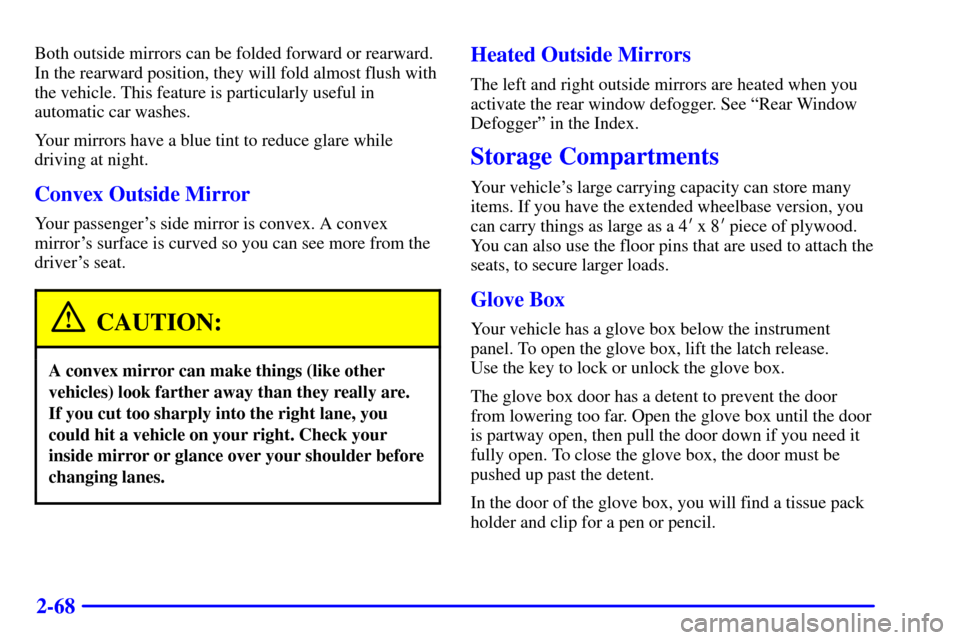
2-68
Both outside mirrors can be folded forward or rearward.
In the rearward position, they will fold almost flush with
the vehicle. This feature is particularly useful in
automatic car washes.
Your mirrors have a blue tint to reduce glare while
driving at night.
Convex Outside Mirror
Your passenger's side mirror is convex. A convex
mirror's surface is curved so you can see more from the
driver's seat.
CAUTION:
A convex mirror can make things (like other
vehicles) look farther away than they really are.
If you cut too sharply into the right lane, you
could hit a vehicle on your right. Check your
inside mirror or glance over your shoulder before
changing lanes.
Heated Outside Mirrors
The left and right outside mirrors are heated when you
activate the rear window defogger. See ªRear Window
Defoggerº in the Index.
Storage Compartments
Your vehicle's large carrying capacity can store many
items. If you have the extended wheelbase version, you
can carry things as large as a 4� x 8� piece of plywood.
You can also use the floor pins that are used to attach the
seats, to secure larger loads.
Glove Box
Your vehicle has a glove box below the instrument
panel. To open the glove box, lift the latch release.
Use the key to lock or unlock the glove box.
The glove box door has a detent to prevent the door
from lowering too far. Open the glove box until the door
is partway open, then pull the door down if you need it
fully open. To close the glove box, the door must be
pushed up past the detent.
In the door of the glove box, you will find a tissue pack
holder and clip for a pen or pencil.
Page 177 of 429
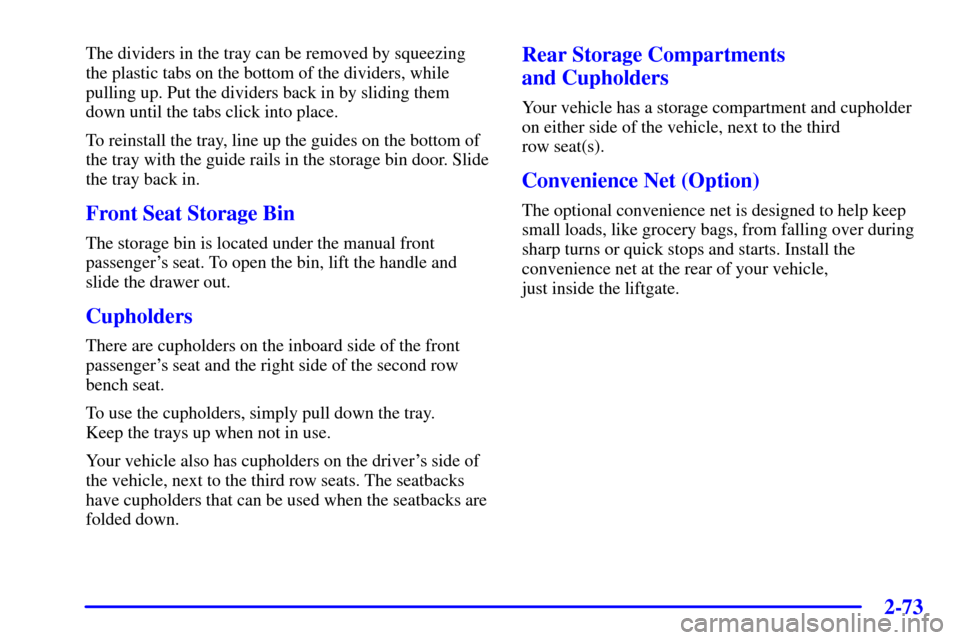
2-73
The dividers in the tray can be removed by squeezing
the plastic tabs on the bottom of the dividers, while
pulling up. Put the dividers back in by sliding them
down until the tabs click into place.
To reinstall the tray, line up the guides on the bottom of
the tray with the guide rails in the storage bin door. Slide
the tray back in.
Front Seat Storage Bin
The storage bin is located under the manual front
passenger's seat. To open the bin, lift the handle and
slide the drawer out.
Cupholders
There are cupholders on the inboard side of the front
passenger's seat and the right side of the second row
bench seat.
To use the cupholders, simply pull down the tray.
Keep the trays up when not in use.
Your vehicle also has cupholders on the driver's side of
the vehicle, next to the third row seats. The seatbacks
have cupholders that can be used when the seatbacks are
folded down.
Rear Storage Compartments
and Cupholders
Your vehicle has a storage compartment and cupholder
on either side of the vehicle, next to the third
row seat(s).
Convenience Net (Option)
The optional convenience net is designed to help keep
small loads, like grocery bags, from falling over during
sharp turns or quick stops and starts. Install the
convenience net at the rear of your vehicle,
just inside the liftgate.
Page 179 of 429
2-75
Side Convenience Nets
The side convenience nets are designed to hold smaller
items (about 8 lbs. (4 kg)) than the large convenience
net. Attach the loops to the posts on the rear side panels,
near the jack storage area.
When not in use, it is recommend that you take down
the convenience nets to extend their life and retain
their elasticity.
Front Seat Storage Net
There is a storage net that stretches between the front
seats. Pull the hooks toward the passenger's seat and
insert them into the holes next to the cupholder.
To store the net, lift the hooks up and out of the holes.
The net does not detach from the driver's seat.
When not in use, it is recommend that you unhook the
net to extend its life and retain its elasticity.
Page 210 of 429
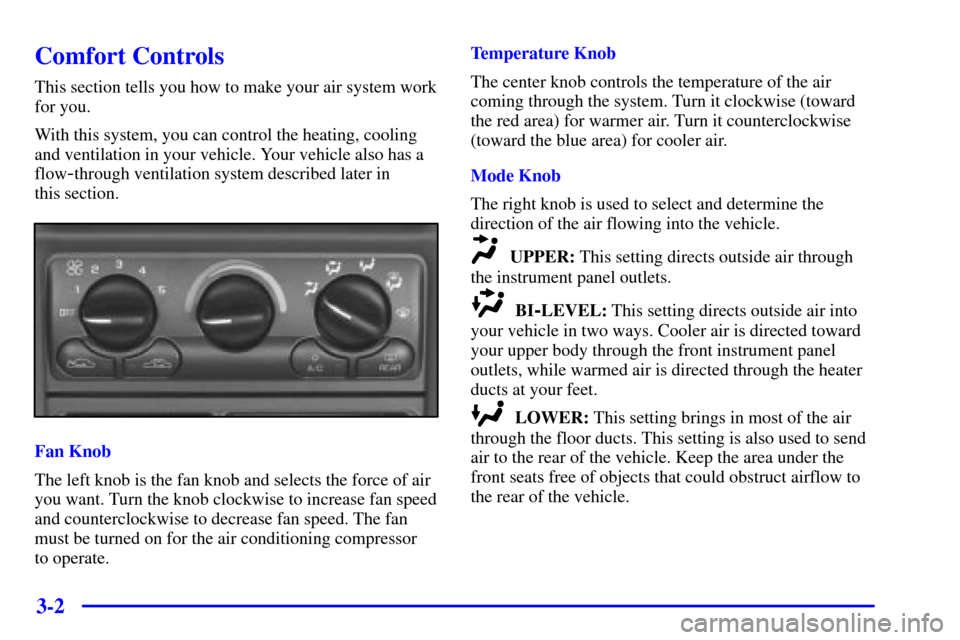
3-2
Comfort Controls
This section tells you how to make your air system work
for you.
With this system, you can control the heating, cooling
and ventilation in your vehicle. Your vehicle also has a
flow
-through ventilation system described later in
this section.
Fan Knob
The left knob is the fan knob and selects the force of air
you want. Turn the knob clockwise to increase fan speed
and counterclockwise to decrease fan speed. The fan
must be turned on for the air conditioning compressor
to operate.Temperature Knob
The center knob controls the temperature of the air
coming through the system. Turn it clockwise (toward
the red area) for warmer air. Turn it counterclockwise
(toward the blue area) for cooler air.
Mode Knob
The right knob is used to select and determine the
direction of the air flowing into the vehicle.
UPPER: This setting directs outside air through
the instrument panel outlets.
BI-LEVEL: This setting directs outside air into
your vehicle in two ways. Cooler air is directed toward
your upper body through the front instrument panel
outlets, while warmed air is directed through the heater
ducts at your feet.
LOWER: This setting brings in most of the air
through the floor ducts. This setting is also used to send
air to the rear of the vehicle. Keep the area under the
front seats free of objects that could obstruct airflow to
the rear of the vehicle.
Page 214 of 429
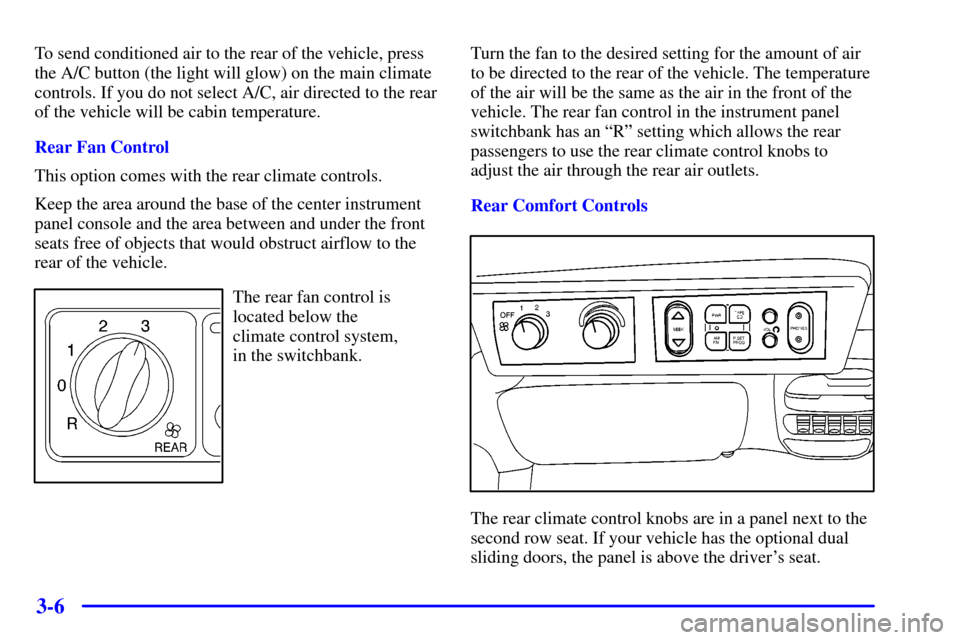
3-6
To send conditioned air to the rear of the vehicle, press
the A/C button (the light will glow) on the main climate
controls. If you do not select A/C, air directed to the rear
of the vehicle will be cabin temperature.
Rear Fan Control
This option comes with the rear climate controls.
Keep the area around the base of the center instrument
panel console and the area between and under the front
seats free of objects that would obstruct airflow to the
rear of the vehicle.
The rear fan control is
located below the
climate control system,
in the switchbank.Turn the fan to the desired setting for the amount of air
to be directed to the rear of the vehicle. The temperature
of the air will be the same as the air in the front of the
vehicle. The rear fan control in the instrument panel
switchbank has an ªRº setting which allows the rear
passengers to use the rear climate control knobs to
adjust the air through the rear air outlets.
Rear Comfort Controls
The rear climate control knobs are in a panel next to the
second row seat. If your vehicle has the optional dual
sliding doors, the panel is above the driver's seat.
Page 215 of 429
3-7
Turn the temperature knob counterclockwise (to the blue
area) for cooler air, or clockwise (to the red area) for
warmer air.
To maintain a comfortable temperature in the rear, use
either rear fan control to adjust the force of air coming
through the rear outlets.
Select the desired climate control mode using the
directional controls on the instrument panel (see ªMode
Knobº earlier in this section). The mode you choose will
regulate both the front and rear climate control systems.Rear Air Vents
To maximize airflow through the rear heater outlet, place
the left bucket seat in the second row in the forward
position (see ªAdjusting Rear Seatsº in the Index).
The vent behind the left rear seat is the cold air return
vent. Be sure to keep it free of obstructions.
Keep the area around the base of the center instrument
panel console, between and under, the front seats free of
objects that could obstruct airflow to the rear.
Page 216 of 429
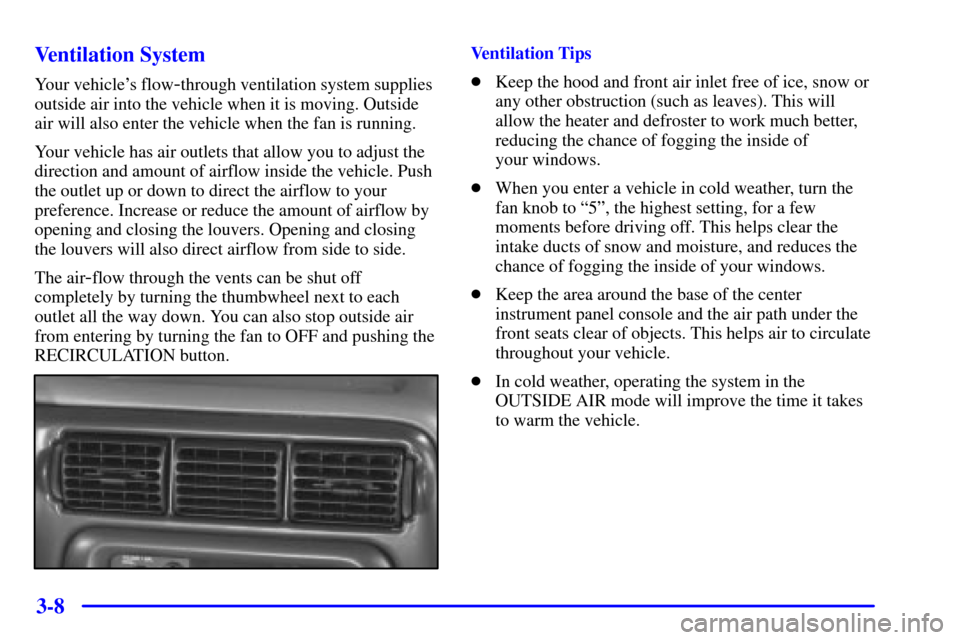
3-8 Ventilation System
Your vehicle's flow-through ventilation system supplies
outside air into the vehicle when it is moving. Outside
air will also enter the vehicle when the fan is running.
Your vehicle has air outlets that allow you to adjust the
direction and amount of airflow inside the vehicle. Push
the outlet up or down to direct the airflow to your
preference. Increase or reduce the amount of airflow by
opening and closing the louvers. Opening and closing
the louvers will also direct airflow from side to side.
The air
-flow through the vents can be shut off
completely by turning the thumbwheel next to each
outlet all the way down. You can also stop outside air
from entering by turning the fan to OFF and pushing the
RECIRCULATION button.
Ventilation Tips
�Keep the hood and front air inlet free of ice, snow or
any other obstruction (such as leaves). This will
allow the heater and defroster to work much better,
reducing the chance of fogging the inside of
your windows.
�When you enter a vehicle in cold weather, turn the
fan knob to ª5º, the highest setting, for a few
moments before driving off. This helps clear the
intake ducts of snow and moisture, and reduces the
chance of fogging the inside of your windows.
�Keep the area around the base of the center
instrument panel console and the air path under the
front seats clear of objects. This helps air to circulate
throughout your vehicle.
�In cold weather, operating the system in the
OUTSIDE AIR mode will improve the time it takes
to warm the vehicle.
Page 281 of 429
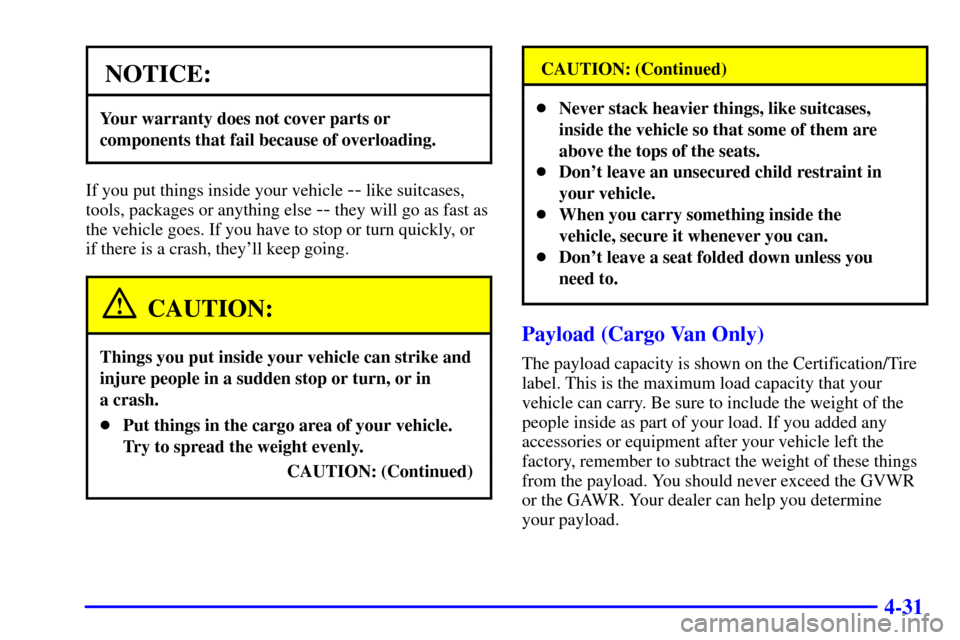
4-31
NOTICE:
Your warranty does not cover parts or
components that fail because of overloading.
If you put things inside your vehicle -- like suitcases,
tools, packages or anything else
-- they will go as fast as
the vehicle goes. If you have to stop or turn quickly, or
if there is a crash, they'll keep going.
CAUTION:
Things you put inside your vehicle can strike and
injure people in a sudden stop or turn, or in
a crash.
�Put things in the cargo area of your vehicle.
Try to spread the weight evenly.
CAUTION: (Continued)
CAUTION: (Continued)
�Never stack heavier things, like suitcases,
inside the vehicle so that some of them are
above the tops of the seats.
�Don't leave an unsecured child restraint in
your vehicle.
�When you carry something inside the
vehicle, secure it whenever you can.
�Don't leave a seat folded down unless you
need to.
Payload (Cargo Van Only)
The payload capacity is shown on the Certification/Tire
label. This is the maximum load capacity that your
vehicle can carry. Be sure to include the weight of the
people inside as part of your load. If you added any
accessories or equipment after your vehicle left the
factory, remember to subtract the weight of these things
from the payload. You should never exceed the GVWR
or the GAWR. Your dealer can help you determine
your payload.